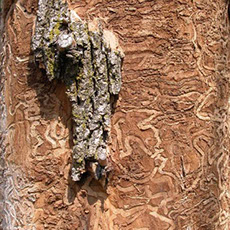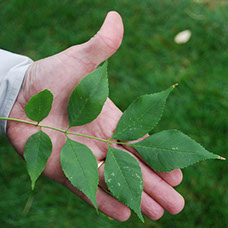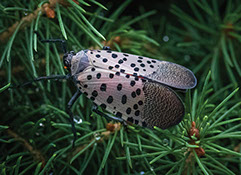
Summer 2020
Invasive Pests and Diseases in Trees and Plants
Following are some of the invasive pests and diseases to look for currently in your trees and plants. Call us if you suspect that they may be present on your property. We recommend the app Seek by iNaturalist as a great tool for identifying trees, plants, insects and animals. All you have to do is snap a photo and the app will instantly try to identify it based on information in the iNaturalist online database and based on your device’s location. Visit iNaturalist.org.
Emerald Ash Borer (EAB)
EAB is a metallic green insect that has killed tens of millions of ash trees in the U.S. and Canada — including ash trees in New York, New Jersey and Connecticut. Experts estimate that, without intervention, all ash trees could be destroyed by EAB within a decade. EAB is well established in our service area at this time so, if you have not yet, please discuss a management plan with your arborist — whether it for is treatment or tree removal. Signs of EAB include the presence of the small, metallic green insect or tiny D-shaped holes, S-shaped galleries and splitting bark (see image). Also look for Woodpecker damage since they seek our EAB and attack them.
Call us for a consultation if you have ash trees on your property to discuss your treatment options. Hint for identifying ash trees: Leaflets are arranged in rows on opposite sides of the central stem (rachis) of the leaf (see image). There are typically 5 to 11 leaflets on an ash tree
Please visit our dedicated EAB portal www.almstead.com/eab.
Spotted Lanternfly (SLF)
SLF is an invasive insect that has been confirmed in multiple counties in New York and New Jersey. It causes harm by sucking sap from plant stems and leaves. This can reduce photosynthesis, weaken the plant and eventually contribute to the plant’s death. SLF targets ailanthus trees, in particular, and attacks a wide variety of crops including grapes, hops, apples and forest products. Nymphs are black with white spots and turn red before transitioning into adults. Adults begin to appear in July and are approximately 1 inch long and ½ inch wide at rest, with eye-catching wings. They are easiest to spot at dusk or at night as they migrate up and down the trunk of the plant.
Hemlock Woolly Adelgid (HWA)
HWA is an invasive, aphid-like insect that attacks hemlocks. They are very small (1.5 mm) and often hard to see, but they can be easily identified by the white woolly masses they form on the underside of branches at the base of the needles. Hemlocks are one of the few evergreen trees that can tolerate shade and are truly an important part of our landscape. If properly maintained, they are a wonderful and sometimes essential tree for many landscapes.
Boxwood leafminer
Boxwood leafminer can be a fairly destructive insect pest of boxwood. The larvae of this fly feed on the tissue between the outer surfaces of the leaves. This feeding of this insect can seriously disfigure the shrubs and results in blotch shaped mines in the leaves. The infested leaves appear blistered from late summer through the following spring.
Boxwood blight
Boxwood blight is a dreaded fungal disease that is very hard to prevent or treat. See our detailed article on boxwood blight here.










LOCATIONS:
Lower Westchester County, NY and New York City
58 Beechwood Ave, New Rochelle, NY 10801
914-576-0193
Upper Westchester (North of I-287)
15 Broadway, Hawthorne, NY 10532
914-741-1510
Fairfield County, Connecticut
547 Hope Street, Stamford CT 06907
203-348-4111
Bergen & Passaic Counties, NJ
504 High Mountain Road, North Haledon, NJ 07508
973-636-6711
Contact us for a Free Consultation